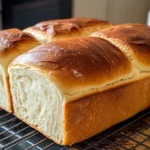Description
“Learn to bake soft, fluffy sourdough sandwich bread with step-by-step instructions, tips, and variations for perfect results.”
Ingredients
1. Sourdough Starter
A lively, bubbly sourdough starter is essential. This mixture of flour and water, which cultivates wild yeast and bacteria, is what naturally leavens your bread. If you’re new to sourdough, you can check out this sourdough starter guide for tips on maintaining it.
2. Bread Flour vs. All-Purpose Flour
For sourdough sandwich bread, bread flour is preferred due to its higher protein content, which helps develop more gluten. Gluten provides the bread’s structure and makes it chewier.
However, all-purpose flour can also work if you’re looking for a softer loaf. A 50-50 mixture of bread flour and all-purpose flour offers a good balance between structure and softness.
3. Water
Water is the main hydrating agent in bread making. The right hydration level will yield a soft crumb without making the dough too sticky.
4. Butter or Oil
Fat differentiates sourdough sandwich bread from rustic sourdough. It enriches the dough, making it softer and providing a tender crumb.
5. Honey or Sugar
Both honey and sugar add a touch of sweetness, feeding the yeast during fermentation, and helping the dough rise properly.
Instructions
1. Sourdough Starter
A lively, bubbly sourdough starter is essential. This mixture of flour and water, which cultivates wild yeast and bacteria, is what naturally leavens your bread. If you’re new to sourdough, you can check out this sourdough starter guide for tips on maintaining it.
2. Bread Flour vs. All-Purpose Flour
For sourdough sandwich bread, bread flour is preferred due to its higher protein content, which helps develop more gluten. Gluten provides the bread’s structure and makes it chewier.
However, all-purpose flour can also work if you’re looking for a softer loaf. A 50-50 mixture of bread flour and all-purpose flour offers a good balance between structure and softness.
3. Water
Water is the main hydrating agent in bread making. The right hydration level will yield a soft crumb without making the dough too sticky.
4. Butter or Oil
Fat differentiates sourdough sandwich bread from rustic sourdough. It enriches the dough, making it softer and providing a tender crumb.
5. Honey or Sugar
Both honey and sugar add a touch of sweetness, feeding the yeast during fermentation, and helping the dough rise properly.
Notes
After baking, allow the bread to cool in the pan for about 10 minutes. This initial cooling period helps the loaf firm up, making it easier to remove from the pan. Once removed, transfer the bread to a wire rack and allow it to cool completely, typically for about 1-2 hours. Cutting into the bread while it’s still warm can result in a gummy texture, as the crumb hasn’t fully set.
